
Introduction
The Canon PRO-100 was announced in September of 2012 and is the successor to the Canon Pro9000 MkII. It is a 13" wide, eight color, dye based photo inkjet printer. Designed for bold color reproduction on any quality inkjet paper, the PRO-100 is a robust photo printer that should be considered by the photo enthusiast, graphic designer, business user, and anyone else needing 13" capability.
Just the Facts
13" wide photo quality inkjet printer
Print 4" x 6" up to 13" x 26" banners
Eight Dye Based Inks - Cyan, Yellow, Magenta, Black, Photo Cyan, Photo Magenta, Gray, Light Gray
Estimated Retail Price $499
Ink Cost - About $16.99 per tank retail
Standard Ink Tanks - Holding about 13mL of ink each
Opening the Box

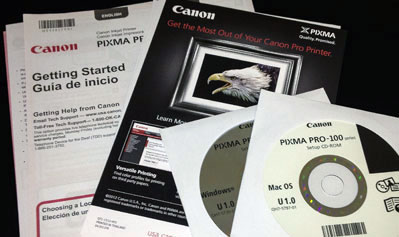
The Canon PRO-100 box arrived in good condition after its long journey. The printer came well packed with all of the accessory pieces stored in separate bags. The printer was in a heavy duty plastic bag with handles, which made getting it out of the box a breeze. After plugging in the printer, the quick start guide got us started in a few simple steps.
The Canon PRO-100 shipping box includes:
- Canon PRO-100 printer
- CD/DVD printing tray
- Inks
- Print Head
- Manual
- Power Cord
- Setup CD
- USB Cable
Canon Pixma Pro-100 Inks
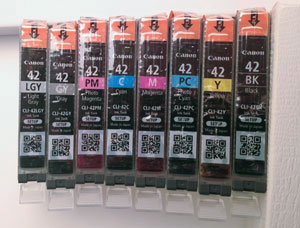
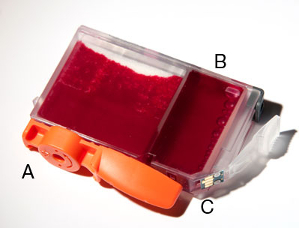
The printer comes with a full set of CLI-42 ink cartridges. A small amount of ink will be used in the printer setup, but you will still have plenty left to make prints and become familiar with the machine.
Anatomy of a Canon ink tank
A - Bottom of ink tank and ink outlet. The orange cap will be removed before ink is installed
B - Ink reservoir. Canon inks have two chambers. The rear area is open, allowing you to visually inspect the ink level. The forward area is packed with absorbent material and holds a portion of the ink volume above the outlet to the printer head.
C - Onboard chip. The onboard chip stores and reports ink level. It does not really know how much ink is physically in the tank. Rather, it starts at 100%, then records nozzle firing data sent from the printer and subtracts volume. The system is very accurate, and you will indeed see a dry tank when it comes time to do a replacement.
Print Head
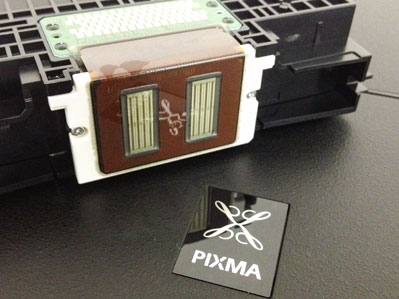
The PRO-100 print head / ink cartridge assembly comes in a separate sealed bag. A large orange plastic cover must be removed to reveal the head (see at right). Installing the head, then inks into their carriage is simple and takes about a minute.
Being able to inspect an inkjet print head up close is very interesting. It gives you a good idea of the amazing technology involved in inkjet printing and the truly small scale of a print head.
Once installed you will see a light on the front of the ink tank illuminate and glow steady red. The same light blinks slowly when you're low on ink and quickly once the tank has been depleted.
Canon PRO-100 Ink Tanks Included
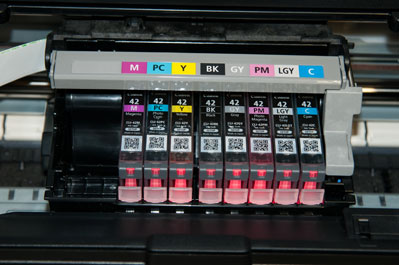
- Black CLI-42
- Cyan CLI-42
- Magenta CLI-42
- Yellow CLI-42
- Photo Cyan CLI-42
- Photo Magenta CLI-42
- Gray CLI-42
- Light Gray CLI-42
Getting Ready to Print
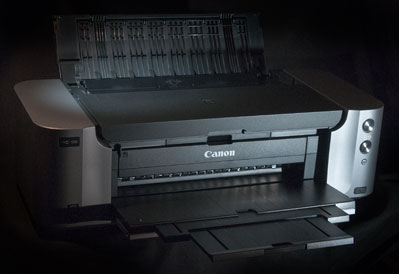
Once all of the inks were installed, the printer charged up and was ready to begin printing in less than five minutes.
The assembled printer is 27.2" wide, 15.2" deep, 8.5" high, and weighs 43 pounds.
You'll want at least 10" of clearance from the back of the printer to the wall for proper operation and use of the specialty paper tray.
When fully extended, the front paper tray extends 12.5" from the front of the printer.
Front Control Panel
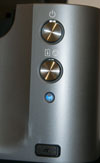
The front control panel of the PRO-10 consists of three controls:
- Power button with light
- Resume / Cancel button with warning light. Errors will be identified by different sequences of blinking. Consult your online manual for help with decoding the sequence should you have a problem.
- Wireless connectivity button with indicator light
Connectivity
The PRO-100 can connect to your computer via USB 2.0, wireless network, or ethernet.
Media Paths
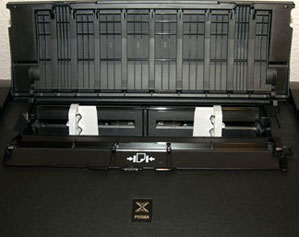
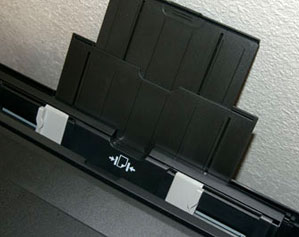
The PRO-10 has two media feed paths and a CD/DVD printing tray
- Rear tray - for the majority of media you'll use
- Manual feed - single sheet tray for heavy and specialty media
Canon notes that the recommended paper capacity for the rear tray is 20 pages for 4" x 6" and 5" x 7" photo media, 10 pages for letter and 8" x 10" photo media and a single page for larger sizes. A single page is also recommended for Fine Art papers.
Red River's experience thus far is that the rear tray can hold up to 50 sheets, depending on the thickness of your paper. Photo papers like luster, satin, and glossy at 10.4mil are expertly handled by the PRO-100 with no misfeeds. If you're using matte paper or thick media, fewer sheets should be fed in at one time. Fine art stock, canvas, and specialty paper should be fed into the manual single sheet path. For some driver media settings, the printer will only allow the single sheet path to be used.
CD Printing Capability
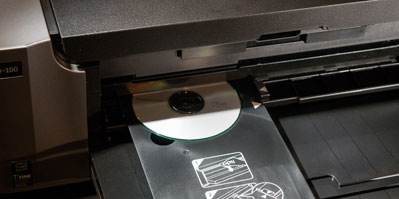
Above you can see the CD holder that comes with the printer. The holder is placed into a front slot on the left side of the machine. Please note that you'll need specialty CD or DVD media coated for inkjet printing.
Canon's My Image Garden software is provided to set up and print discs.
Print Speeds and Results
Print Quality
The Canon PRO-100 offers what we can only describe as continuous tone photo printing. That is to say when you're printing a typical photograph, the dots of ink that make up the photo are not visible at normal viewing distance or even fairly close inspection. This is especially true when printing on satin, luster paper, and glossy media. Solid blocks of color are uniform and smooth looking. Only in some mid-tone areas will you occasionally see a few dots. Again, one would need to be unnaturally close to the print to see them! As far as inkjet printing goes, the PRO-100 produces outstanding photo quality.p>
Print Speed
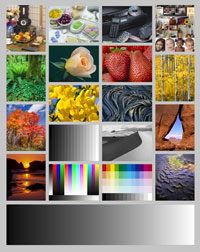
An 8" x 10" file at 240ppi (shown above) was printed and timed using the settings listed below:
Luster Paper Highest Quality (Level 1) = 2 minutes 21 seconds
Luster Paper High Quality (Level 2) = 1 minute 36 seconds
Luster Paper Standard Quality (Level 3) = 50 seconds
Matte Paper High Quality = 2 minutes 19 seconds
Matte Paper Standard Quality = 1 minute 34 seconds
Quality Settings
We printed the target file on UltraPro Satin and 47lb. Premium Matte using the Photo Paper Pro Luster and Matte Photo Paper media settings, respectively. The prints were allowed to dry eight hours, and then evaluated under balanced 4700k Solux lights.
Our initial evaluation revealed little obvious difference between the prints. Saturation and color balance were similar. Even solid color patches and transitions were hard to distinguish upon casual viewing.
Closer inspection of the Standard quality print revealed a slight reddish cast, especially in grayscale transition areas. The cast disappeared and grays shifted back to neutral at the higher settings.
The biggest difference between Standard and higher quality settings was edge definition and clarity. You can see the difference in these macro shots below.
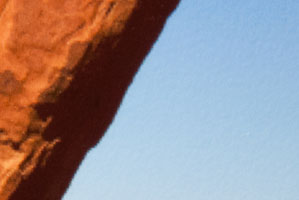
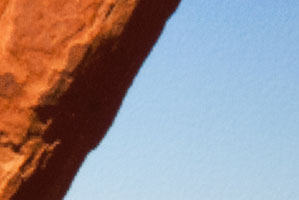
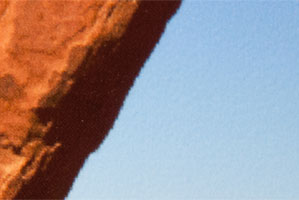
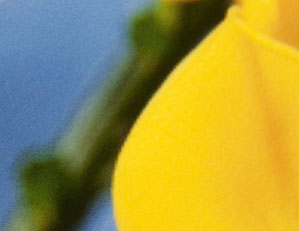
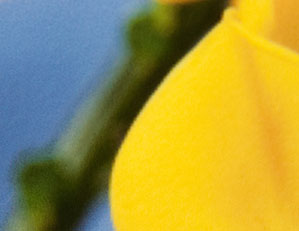
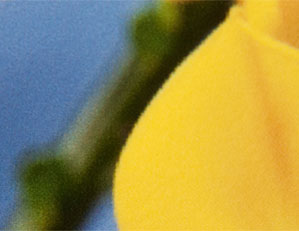
The difference between Standard quality level 3 and the higher quality prints is apparent. Keep in mind that these are macro image and the difference is not striking at viewing distance. Still, the smoother dot pattern and cleaner edges of quality level 2 and 1 will result is sharper looking prints.
Our conclusion is that Level 2 High print quality is the best setting for most photo projects. The Level 1 setting does not result in appreciably better print quality and takes 38% longer to complete.
Black & White
For the first time, Canon has included gray and light gray inks in a PRO level dye based printer. In combination with black, these two new tanks greatly help the B&W output of the PRO-100. That said, some printers are not really designed with neutral B&W in mind. In some cases, they have some thought of B&W infused into them, but in a limited way. The PRO-100 is such a printer. Canon's primary intent with the PRO-100 is color photography. In addition, available ICC profiles contain color information and work for B&W printing in a limited capacity.
A quick summary of PRO-100 B&W printing "modes" is:
1) Print a file that is converted to B&W and in the RGB color space (Adobe RGB preferred) using a printer profile for your paper.
2) Print a file that is converted to B&W and in the RGB color space (Adobe RGB preferred) letting the printer manage colors. Note that this method can require testing a couple of media settings for best results. Media settings have an outsized affect on B&W tonality on the PRO-100.
3) Print a file letting the printer manage colors with the driver in Black & White mode.
For the PRO-100, using the third way, using the printer's Black & White mode, is usually the easiest way to get neutral tone prints.
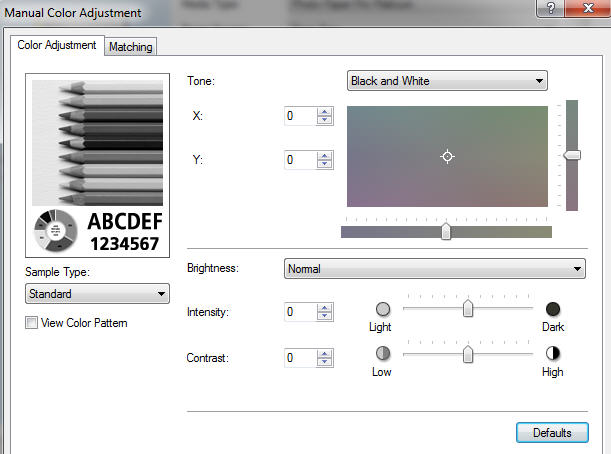
PRO-100 Driver Black & White Mode
Our tests consisted of printing the 8x10 test print (shown above) using the driver B&W feature. Photoshop was set to Printer Manages Color and no adjustments were made to the target file. We printed the target using the default, Cool Tone, and Warm Tone settings. After drying for eight hours the prints were evaluated under balanced Solux light.
Neutral - neutral grays with little or no color cast
Cool Tone - a very slight shift to blue and a cooler look
Warm Tone - a light but noticeable warm shift with a slight yellow tone
Tone can also be controlled via X and Y variables, slider bars, or by placing your mouse inside the Tone box.
Brightness settings include normal, light and dark. Intensity and contrast are sliders allowing for finer adjustments.
All of these adjustments will be "previewed" using a standardized sample image. The drop down menu below the pencil photo at right allows you to choose different preview samples. What actually happens on your printed image may be different. We suggest being judicious with changes and make small test prints when getting started.
You will benefit from well prepared files, which means proper exposure as well as some additional mid-tone contrast. Both are helpful in adding the proper amount of intensity and life into a black & white print.
Canon Pro-100 Printer Driver Tour
Quick Setup Tab
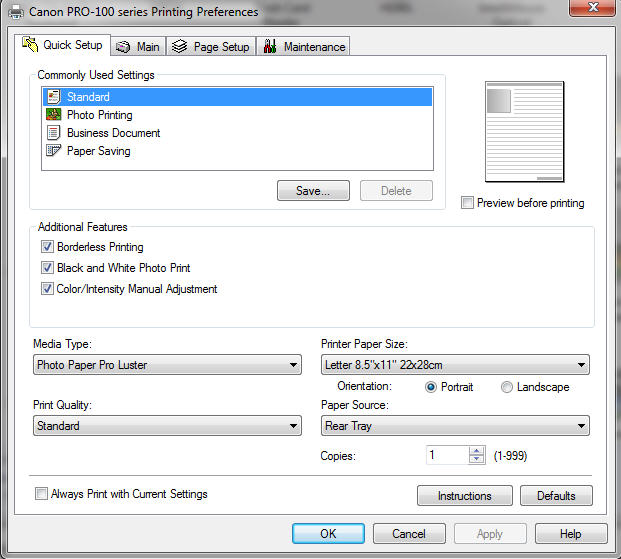
The Canon PRO-100 printer drivers are basically unchanged from previous PRO printer models. We're starting on the Quick Setup tab, which contains most of the controls you'll need for printing.
From this menu you can choose the media type (paper type), paper size, print quality, and other important features.
Main Tab
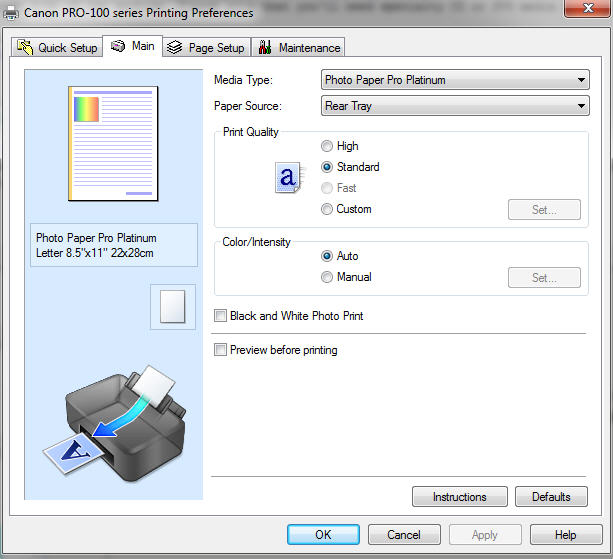
We recommend using this screen as much as possible as it gives you access to the custom print quality and manual color controls.
Media Type
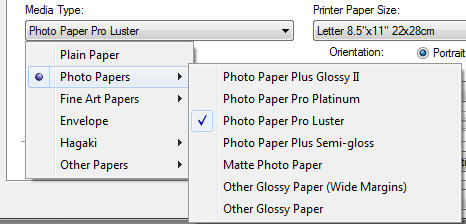
When setting up a print job, you must tell the printer the type of inkjet paper (media) that you are using. Think of the media type as part color profile and part ink throttle. Different inkjet papers need different amounts of ink to perform properly - and this is where the media setting becomes important.
If you are using ICC color profiles, the media type is critical. You have to set the media according to your profile's instructions in order to get the best results.
Note! You will not see alternative paper brands, such as Red River Paper, in this listing. Only manufacturer inkjet media are in this drop down.
Fine Art Margins - If you choose a fine art or non-Canon specialty media type, the printer driver forces a 30mm (1.18") margin to the top and bottom of your print. The left and right margins are set at 3.4mm (0.13"). The media settings also limit the available paper size you can use to:
- Letter
- A4
- A3
- A3+ 13x19
The feature is most likely an attempt to minimize possible head strikes at the beginning and ending of a print when using "fine art" papers. As a result, Red River Paper and other paper companies have chosen to make their fine art printer profiles with the Matte Photo Paper setting, which avoids the size and margin constraint.
Quality Options

Print quality can be controlled from the Quick Setup and Main tabs.
Quality Choices
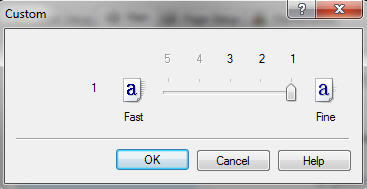
On either the Quick Setup or Main tab, quality settings of Standard and High are available when using photo quality media.
To access the custom quality menu, go to the Main tab, click on the Custom radio button, and then click Set. A slider controls the print quality setting. Level 2 corresponds to High and Level 3 to Standard quality. You will also find a third quality choice, the Level 1 setting. Canon has not given this setting a named label. We will call it "Highest" for the purposes of this review.
Only glossy, semigloss, and luster media settings have Highest quality as an option. Lower quality settings, such as Fast (Level 4), are available when plain paper or envelope media are selected. You would choose this setting for text and light graphic printing.
Color / Intensity

The PRO-100 driver color controls have an Auto and Manual mode. In Auto mode, the printer is completely in control of color management. You'll choose this setting if you are not using a printer color profile, and if you have found the printer's default setting to offer adequate output quality.
If you need to make slight adjustments to the printer's color output, you can click on the Manual radio button then the Set button for the Manual Color Adjustment menu.
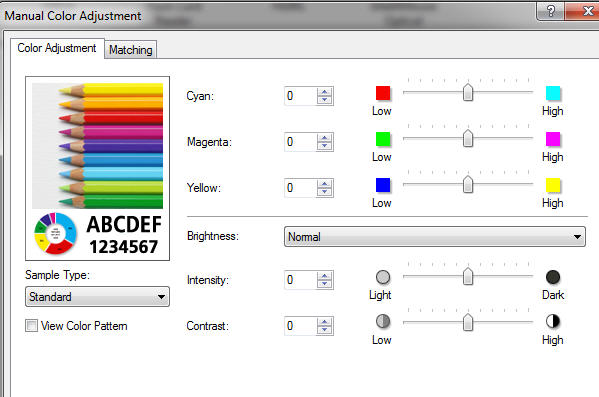
On the Color Adjustment tab you'll find a number of sliders. These are "rough" controls for color saturation, brightness, intensity, and contrast. We say rough because there is no color managed preview of your image with the changes. The workflow pattern would normally be print, adjust, print, and adjust until you got the desired results.
One answer to the problem is to always use a printer color profile for the PRO-100 and your paper. Profiles take the guesswork out of correction and faithfully reproduce your file to the best of your paper's ability.
For those not swayed by the printer profile argument, Canon has a feature called Pattern Print. Accessible from the printer properties (Windows) or the Print Studio Pro plug-in, Pattern Print will setup and print a repeating series of your image on a single sheet of paper. The pattern represents and denotes various changes to color or brightness/contrast settings. Upon consulting the choices, you can dial in the recommended changes into the printer's color adjustment controls. Make sure you let the test print dry at least an hour, preferably longer, before making any decisions.
Below is a screen shot from Print Studio Pro showing the pattern layout and recommended Cyan, Magenta, and Yellow settings to achieve the look of each variant.
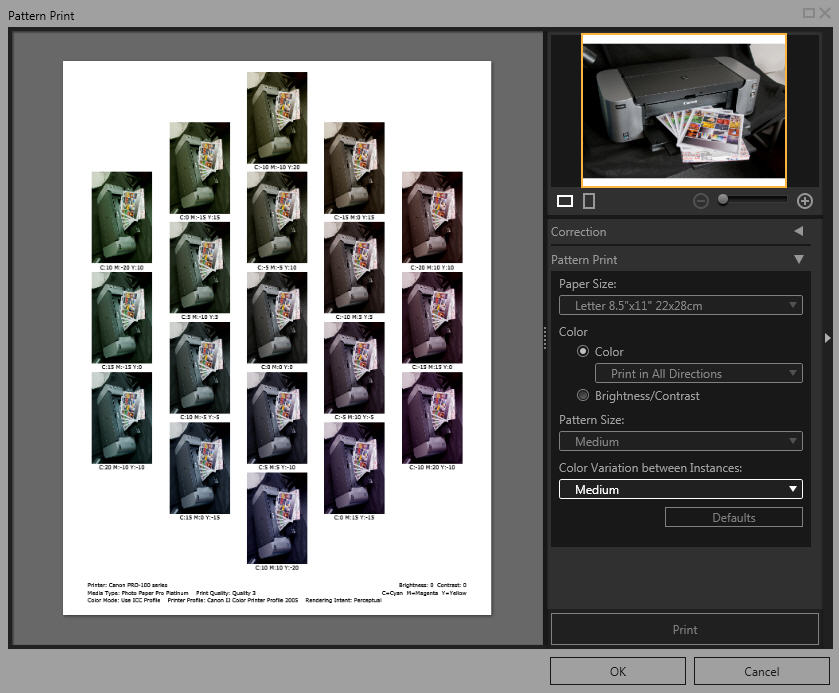
If you are using a printer color profile (ICC profile), then you will select the Matching tab. Under the heading Color Correction you'll find:
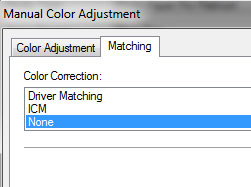
Driver Matching - this is the default setting for printer color management
None - this setting completely turns off the printer's color controls. Use this setting when you have a printer color profile and are using it to print via Photoshop, Photoshop Elements, Lightroom, Qimage, and the like.
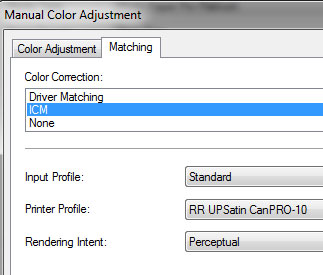
ICM - Rarely used, ICM allows you to print using a printer color profile from software that is not "ICC aware". This applies to basic photo software and layout tools where the developers did not know of or consider color management important.
Page Setup
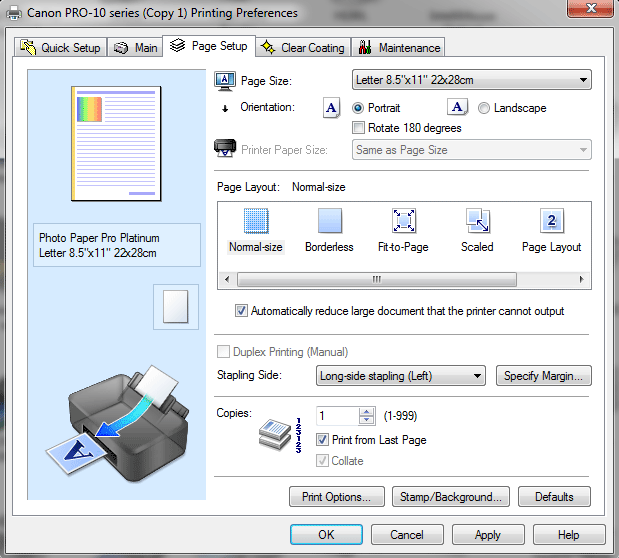
Controls for paper size, print orientation, and layout options are on the Page Setup tab.
Borderless Options
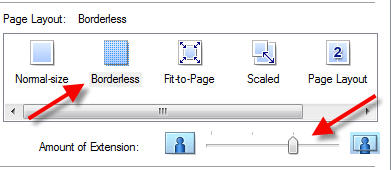
Of particular interest are the Borderless print controls. When Borderless is selected, you will notice the Amount of Extension slider appear. When printing without borders, the PRO-100 will automatically stretch out the edges of a file to insure ink covers the edges of the paper. You can increase or decrease this function. Move the slider to the left for more extension. If you have a photo with important details at the edges reduce the amount of extension to avoid those areas being cut off.
Borderless is in option with the following media settings:
- Photo Paper Pro Platinum
- Photo Paper Plus Glossy II
- Photo Paper Pro Luster
- Photo Paper Plus Semi-gloss
- Matte Photo Paper
Borderless Sizes Choices
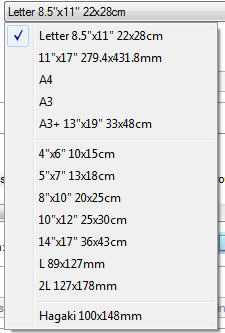
Above you'll see all of the possible Canon PRO-100 borderless size options. These are set by the factory and cannot be modified.
Read our 11x14 Borderless Hack for the PRO-100.
Custom Paper Sizes
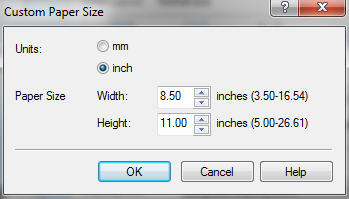
Like other Canon printers, the PRO-100 allows you to define custom paper sizes. The limits:
Paper Width: 12.95" - After some experimentation, we found that a custom size set to 13" causes a print error. Using 12.95" fixed that issue. You will notice 16.54 on the width scale. This seems to be a software coding error.
Paper Height: 26.61" - We found the effective maximum print height is 26".
Maintenance Tab
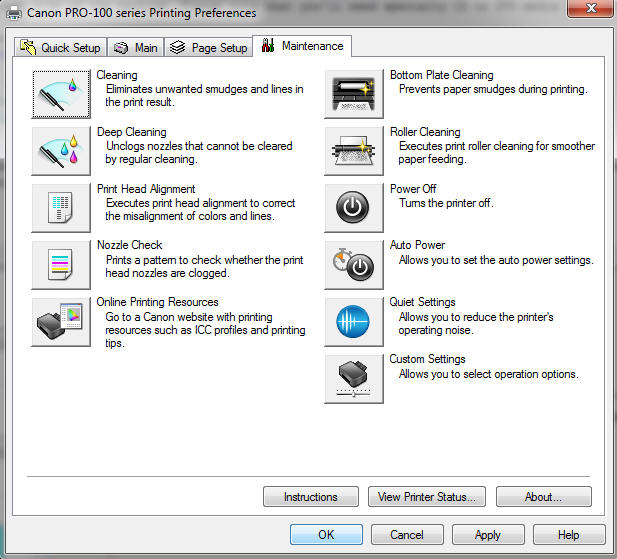
The Nozzle Check, Head Cleaning, and Print Head Alignment are all critical tools to have if you experience a drop in print quality. You can call up your printer status dialog from this screen.
Custom Settings
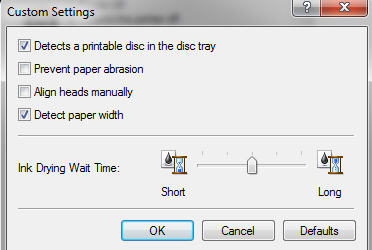
You will find a very important control in the custom settings menu, Prevent Paper Abrasion. Always turn it on when you use heavy or specialty media. We recommend using the feature with papers over 12mil thickness.
Ink Drying Wait Time controls the pause between print head passes. Because dye inks dry rapidly the setting will likely not need to be changed.
If you use custom sizes and encounter a driver error relating to paper size and setting compatibility, try turning off the Detect Paper Width.
Included Software
Descriptions are taken from the Canon online manual.
My Image Garden
My Image Garden is an application that allows you to utilize photos taken with digital cameras and other images saved on your computer, in many ways for various purposes. You can organize a vast number of images easily, or create collages, cards and other items from your favorite photos and print them. Moreover, you can perform various scans with one click.
Print Studio Pro
Print Studio Pro is a plug-in that makes professional photo printing easier and more convenient.
In addition to printing bordered photos and borderless photos, you can perform various printing tasks such as index printing, grayscale printing and printing using ICC profiles. You can also adjust the margins or add text.
Quick Menu
Quick Menu is software that allows you to easily start the applications and manuals supplied with the machine, or quickly access online product information. In addition, with simultaneously installed Image Display, you can enjoy patterns of collages and other items created automatically by the item recommendation function of My Image Garden as well as slide shows of images saved on a computer.
Easy-WebPrint EX
Easy-WebPrint EX is software that allows you to easily print web pages displayed in Internet Explorer.
You can print a web page by automatically reducing its size to fit the paper width to prevent the edges from being cropped or by selecting pages in preview.
My Printer
My Printer is an application that allows you to display the setting screen of the printer driver or look up solutions to operational problems.
Red River Paper Compatibility
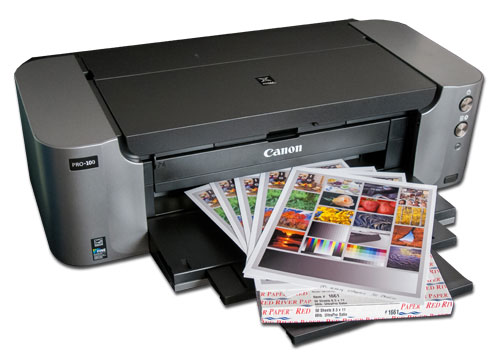
Our line of Premium Inkjet Papers includes over 30 that Work Well in the Canon PRO-100. You can See the Best Compatible Photo Paper for the PRO-100 and Order a Sample Kit to Test.
Print Testing
We made a number of prints on all compatible Red River papers from 4x6 up to 13x19. In most cases we used Printer Color profiles for the PRO-100. Using profiles is always a good idea, and in the case of this new printer they really help increase the saturation and color accuracy.
Glossy Papers
Smooth glossy papers like Red River UltraPro Gloss 2.0 take advantage of the PRO-100's bold color gamut and tack sharp print detail.
Satin / Luster Papers
The light texture of satin and luster papers are another "must try" for the PRO-100 owner. The satin surface minimizes fingerprints and better withstands handling. Red River's ever-popular UltraPro Satin and true professional grade Arctic Polar Luster are sure to please when paired with the PRO-100.
Photo Metallic Paper
Polar Gloss Metallic 255 (formerly 66lb. Polar Pearl Metallic) allows you to capture the look of Kodak Endura Metallic™ on your home inkjet printer. Images virtually jump off the page and colors are vibrant and almost luminous.
Photo Matte
Matte papers are smooth and have no reflection. They are perfect for images and work where fine detail is important. A flat surface means more light gets directly back to your eyes. This means you see more detail and are not distracted by glare. Prints on 60lb. Premium Matte PLUS on the PRO-100 show good detail, well balanced color and good saturation. You will greatly benefit from use of printer color profiles when printing on matte surfaces.
Fine Photographic, Art, and Canvas media.
The new, easier to use single sheet tray makes using thick fine art and canvas media a joy. Make sure to set the "Prevent Paper Abrasion" feature in the printer's utility when using these inkjet papers. Prints on Red River Palo Duro Baryta Fiber 300 and Blanco Matte Canvas looked great and help highlight the versatility of the PRO-100.
First Impressions
After spending five days with this printer and printing about 100 images, we find the Canon PRO-100 an excellent replacement for the Pro9000 MkII. The printer's speed and color quality are on par if not slightly better than the older machine. The addition of a specialty media path for thick papers is evidence that Canon acknowledges the advanced printing requirements of their photo enthusiast customers.
Positives
- Photo quality from the PRO-100 is amazing and is for all intents continuous tone. Dots become visible only on magnified inspection of a print.
- Excellent color gamut made even better with printer profile use.
- Good black & white capability with the addition of gray and light gray inks. Specific B&W software controls make the task of grayscale printing easier and more predictable.
- Rapid print speed.
- Robust paper handling from both the regular paper tray and the single sheet specialty path.
- Compatible with virtually any quality inkjet paper.
- Better fade resistance from ChromaLife 100+ inks.
The Ferrari of Inkjet Greeting Card Printers
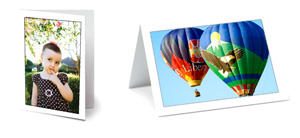
If you're serious about printing photo note cards, we have to say that the PRO-100 is an excellent printer for the job. Like most Canon printers, the PRO-100 will feed card stock consistently through the standard paper tray. Being able to put a stack of Pecos River Gloss Note Cards into the tray, set the job and walk away is huge for card printers. Add in the speed, photo quality, and robust build and you have a professional quality desktop card printing system.
Issues
There are a couple of items that we hoped would be addressed with this new 13" wide dye ink printer. First, we missed 11x14 as an available borderless size. Read our 11x14 borderless hack for the PRO-100
Have Questions? Want to Know More?
Please Contact us via the Support Center with your questions about the PRO-100, or anything inkjet related. We're happy to share our knowledge from 15 years in inkjet printing with you!
Best Inkjet Papers for the Canon PRO-100 Printer
Find the Most Popular Compatible Papers for the Canon PRO-100.
Get a Sample Kit for the PRO-100.
Last updated: January 02, 2024




